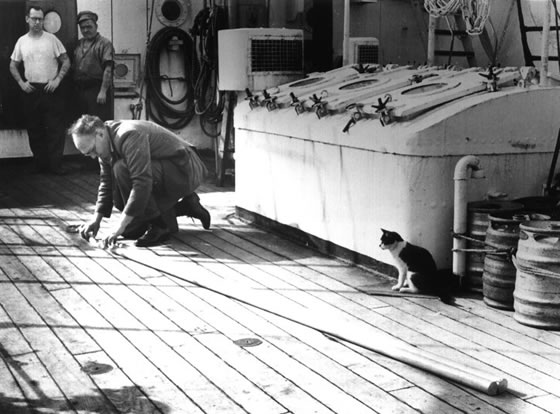First Floats
The concept of using neutrally buoyant floats that drifted at depth to elucidate more about ocean currents was first developed in the 1950s. The idea came about independently in the UK and the USA simultaneously (Swallow, 1955 and Stommel, 1955; respectively).
In the UK, John Swallow worked at the National Oceanography Institute applying his practical understanding of oceanography to develop, construct and test the first floats. Swallow realised that the original idea of tracking slowly sinking sonobuoys to derive current profiles would not work due to the compressibility of materials and seawater and the difficulty in making waterproof seals that could withstand deep-sea pressures.
Swallow therefore concluded that the floats should be designed to stabilise at some level within the water column. This was the same conclusion that Stommel had come to on the other side of the Atlantic. The ideas of Swallow and Stommel seemingly only differed in their approach to the sound-tracking of the floats: Swallow’s idea being to use hydrophones to track a continual sound signal; Stommel’s being to use Sound Fixing and Ranging (SOFAR) to track intermittent sound signals created by regular explosions attached to the floats.
Unlike Stommel, Swallow had the relevant practical knowledge and resources to start work on the construction of the first floats in 1955. Aluminium scaffolding poles were used as they could withstand compression in seawater at depth and were readily available. To reduce the thickness of the aluminium the tubes were thinned in caustic soda – two 3-m lengths of tubing provided sufficient buoyancy for the float to be able to stabilise at 1000 m with a precise negative buoyancy of 38 g. The sound source used to track the float was a simple electronic circuit that produced 10 kHz signal, which was sealed within the aluminium tubing.

John Swallow assembling a float on RRS Discovery II, watched intently by two matelots and the ship's cat
Floats were initially tracked using two hydrophones attached fore and aft of an attendant ship. As the ship’s heading changed the separation and convergence of signal arrivals gave the position of the float relative to the ship. At this time however, navigation over large parts of the ocean was still reliant on sun and star sights, dead reckoning and taking radar fixes on moored buoys and positions relative to submerged topographic features.
Swallow’s experiments indicated that real ocean currents did not always behave in the way suggested by theory. These floats revealed for the first time the mesoscale currents that are now known to populate the open ocean.